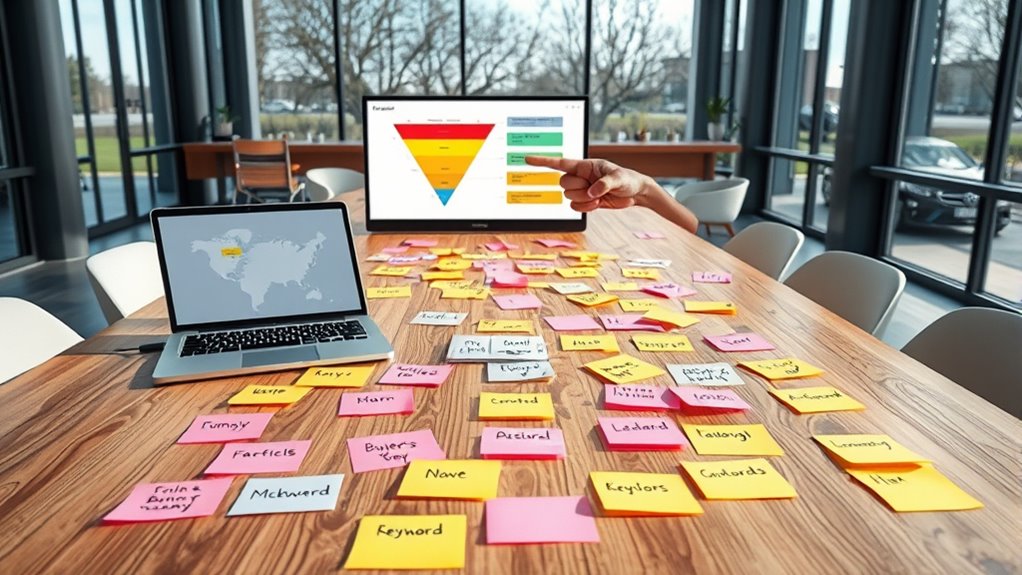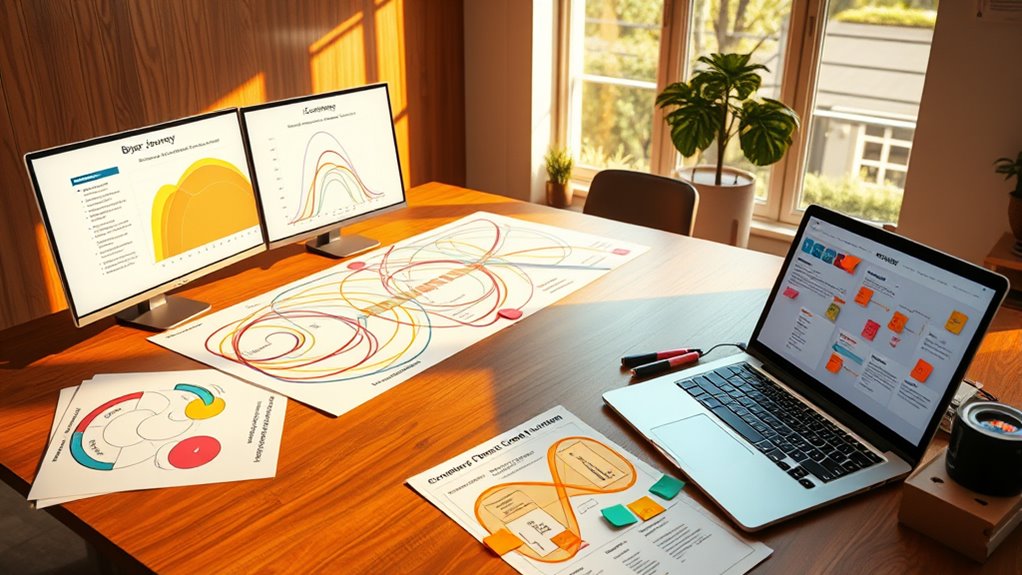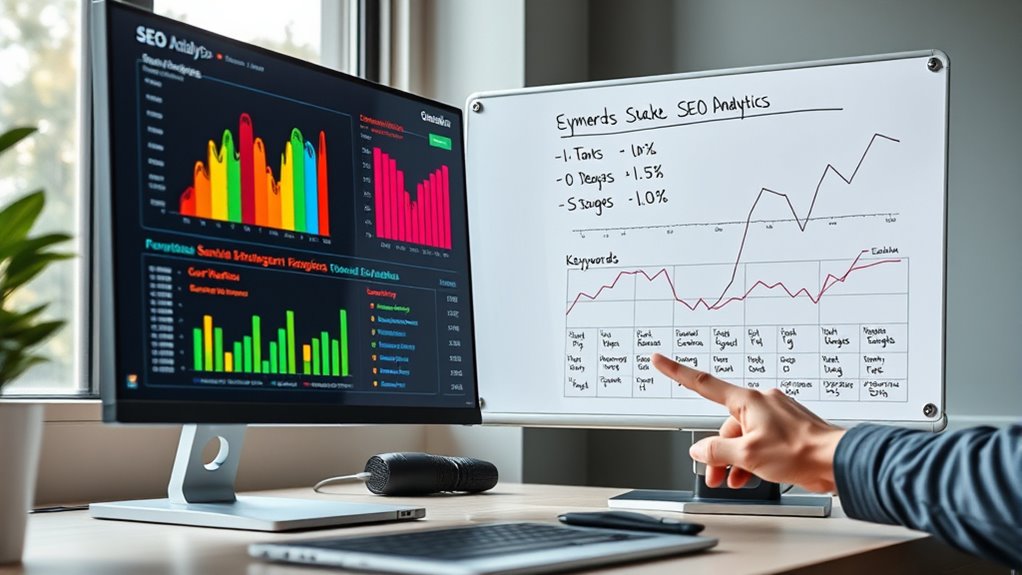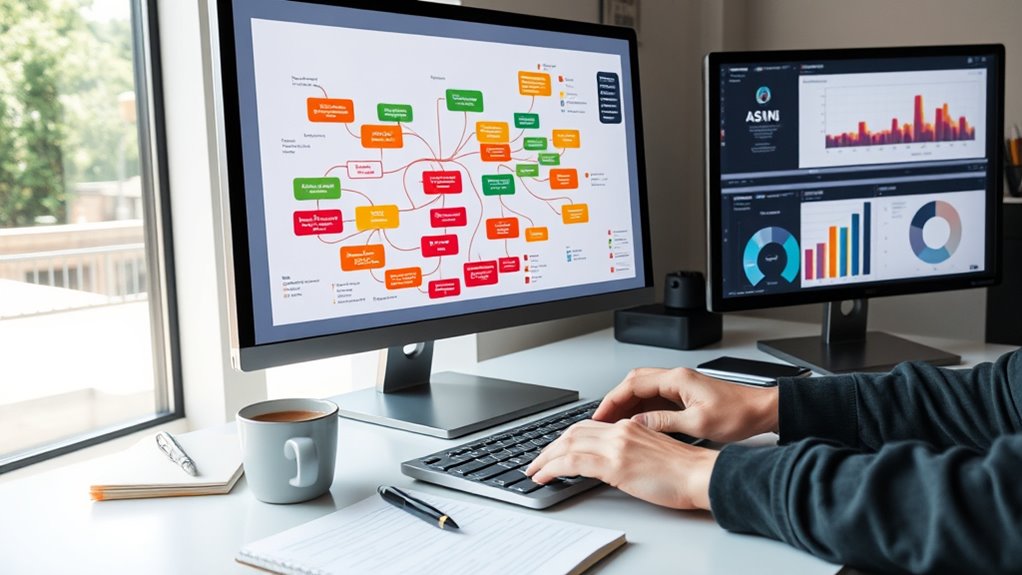To map keywords to the buyer’s journey for full-funnel SEO, start by understanding each stage—awareness, consideration, decision, and retention—and the user intent behind searches. Use targeted keywords, including long-tail phrases, for each phase, ensuring content matches what users seek at that moment. Analyze competitors and monitor keyword performance over time, adjusting your strategy accordingly. Continuing with this approach will help you attract qualified traffic and guide prospects smoothly toward conversion.
Key Takeaways
- Align keywords with each buyer journey stage: awareness, consideration, decision, and retention, to ensure relevant content targeting.
- Use broad, informational keywords for top-of-funnel content and transactional, high-intent keywords for bottom-of-funnel pages.
- Conduct keyword research to identify high-volume and long-tail keywords tailored to user intent at each stage.
- Map content themes and types—blogs, case studies, product pages—to corresponding keywords across the funnel.
- Continuously monitor and refine keyword mappings based on performance metrics and evolving user search behavior.
Understanding the Buyer’s Journey and Its Stages

Understanding the buyer’s journey is essential for creating effective SEO strategies, as it maps out how potential customers discover and decide on your products or services. To do this effectively, you need to develop detailed buyer personas that represent your ideal customers. These personas help you comprehend their needs, pain points, and decision-making processes. Additionally, market segmentation allows you to categorize your audience based on demographics, behaviors, or interests, making it easier to tailor your content. By aligning your SEO efforts with each stage of the buyer’s journey, you ensure your content resonates with users at the right moment—whether they’re just researching solutions or ready to make a purchase. This targeted approach ultimately increases your chances of converting prospects into loyal customers. Recognizing the different stages, such as awareness, consideration, and decision, helps you craft content that guides prospects effectively throughout their journey.
Identifying User Intent at Each Stage of the Funnel

To effectively tailor your SEO efforts, it’s essential to identify user intent at each stage of the funnel. Knowing whether users seek information, comparison, or purchase helps you craft content that enhances brand storytelling and boosts user engagement. Focus on these key intents:
Understanding user intent at each funnel stage helps craft targeted content that drives engagement and conversions.
- Awareness Stage: Users are seeking educational content, so focus on informative articles that introduce your brand’s story. This is the perfect opportunity to highlight Home Improvement tips like maximizing space and organization to capture their interest early.
- Consideration Stage: Users compare options; highlight benefits and unique value propositions to foster engagement. Providing insights into decluttering strategies and their emotional benefits can help users evaluate your solutions.
- Decision Stage: Users are ready to buy; optimize for transactional keywords and clear calls-to-action. Showcasing multi-functional furniture or vertical storage solutions can guide them toward making a purchase.
- Retention Stage: Post-purchase, aim to strengthen relationships with personalized content that encourages ongoing engagement. Sharing tips on mindful decluttering and sustainable living can keep customers connected and returning for more advice. Integrating AI-powered tools can further personalize and optimize content for each user’s stage in the funnel.
Recognizing these intents ensures your content aligns with the user’s journey, guiding them seamlessly through each phase.
Conducting Keyword Research for Awareness Stage

To start your awareness stage keyword research, focus on identifying broad topics your audience cares about. Use keyword tools to analyze search intent and discover what questions or problems your prospects are exploring. This approach helps you create content that attracts attention early in their buyer’s journey. Incorporating essential oils and their associated health benefits can also help you target specific health concerns, positioning your content as a valuable resource at this stage. Additionally, understanding the aromatic cleaning power of essential oils can attract users interested in natural and chemical-free cleaning solutions. Exploring the safety precautions and dilution guidelines associated with essential oils can further enhance your content’s relevance and credibility, ensuring you address common questions and concerns from both beginners and experienced users. Recognizing the importance of proper storage tips can also help your audience maintain the potency and safety of essential oils over time. Moreover, emphasizing the lifestyle benefits of using natural products can resonate with health-conscious consumers seeking holistic wellness solutions.
Identifying Broad Topics
Have you ever wondered how to identify the broad topics that resonate with your target audience early in their buying journey? To do this effectively, focus on uncovering key content themes that align with their interests and needs. These themes form the foundation of your topic clusters, which group related ideas for better organization and SEO impact. Consider these strategies:
- Review industry blogs and forums for common questions.
- Analyze competitors’ content to spot gaps and popular topics.
- Use keyword tools to find high-volume search terms related to your niche.
- Talk directly with your audience through surveys or social media.
- Incorporate insights about air purification and filtration, such as HEPA filters and dust removal technology, to ensure your content aligns with their interests.
- Pay attention to dog care topics like nutritious snacks, grooming, and training, which are frequently searched by pet owners seeking guidance and solutions.
- Explore food-related topics like gelato flavors and types, which can attract a target audience interested in dessert options and culinary trends.
- Additionally, consider how indoor gardening trends, including unique planters and watering solutions, can help position your content to appeal to plant enthusiasts.
Analyzing Search Intent
Ever wondered how to uncover what your audience is truly searching for during their initial discovery phase? Analyzing search intent helps you understand user behavior and what motivates their queries. By examining the language, keywords, and phrasing users employ, you can identify whether they’re seeking information, solutions, or general knowledge. Focus on intent signals like question words or broad terms that indicate awareness-stage searches. This approach allows you to tailor your content to match their needs, providing value and building trust early on. Recognizing search intent ensures you’re targeting the right keywords, increasing the chances of attracting relevant traffic. When you align your SEO strategy with user behavior, you create a foundation for guiding prospects seamlessly into the next stages of their buyer’s journey. Incorporating an understanding of Eye Patch benefits can also help refine your content to better match user expectations at this stage. Understanding search behavior patterns can further enhance your ability to predict and meet user needs effectively. Additionally, awareness of curiosity-driven motivations can help you craft content that resonates with users’ desire to explore and learn more.
Using Keyword Tools
Starting your keyword research for the awareness stage requires leveraging powerful keyword tools that reveal what your target audience is searching for at the beginning of their journey. These tools help you identify keywords with high search volume and ideal keyword density to attract early-stage prospects. To maximize effectiveness, focus on these key aspects:
- Use tools like Google Keyword Planner or SEMrush to discover relevant keywords.
- Prioritize keywords with high search volume to reach more potential visitors.
- Monitor keyword density to avoid over-optimization while maintaining relevance.
- Explore long-tail keywords that indicate informational intent.
Selecting Keywords for Consideration and Evaluation

When prospects enter the consideration and evaluation stage, selecting the right keywords becomes essential for capturing their interest. Focus on keywords related to brand storytelling and visual branding, as these connect with their desire to understand your unique value. Use terms that reflect their questions, such as “best visual branding strategies” or “brand storytelling examples,” to align with their research process. These specific keywords can be further refined by understanding support hours and how they impact customer experience, emphasizing your awareness of operational details that matter to consumers. Recognizing the importance of website performance metrics can help tailor your content to better meet user needs. Incorporating popular juice brands and their health-conscious attributes into your content can demonstrate your awareness of trending health topics and consumer preferences. Additionally, understanding content relevance and authority is crucial for creating content that resonates during this critical phase, increasing the likelihood they’ll move closer to making a decision based on how well your messaging matches their needs. This targeted approach ensures your content resonates during this critical phase, increasing the likelihood they’ll move closer to making a decision based on how well your messaging matches their needs.
Targeting Decision-Stage Keywords to Drive Conversions

When targeting decision-stage keywords, focus on crafting compelling calls-to-action that motivate immediate response. Highlight the key benefits of your products or services to reinforce value and build confidence. These strategies can substantially increase your chances of converting prospects into customers. Incorporating sound design techniques into your messaging can further inspire homeowners to take action. Additionally, emphasizing insights from established personality assessments like the 16PF can help tailor your messaging to resonate more effectively with your target audience. Developing a methodical testing process can ensure your messaging strategies are continually optimized for better results.
Crafting Persuasive Calls-to-Action
Have you ever wondered why some calls-to-action (CTAs) effectively convert visitors into customers while others fall flat? The secret lies in crafting persuasive language that compels action. A strong call to action should be clear, urgent, and aligned with your audience’s needs. To maximize conversions, focus on these key elements:
- Use action verbs that inspire immediate response
- Highlight the benefit or value of taking action
- Create a sense of urgency or scarcity
- Keep the language concise and direct
A compelling call to action guides decision-stage prospects seamlessly toward conversion. When your CTA is persuasive, it taps into the visitor’s motivation, making them more likely to engage and convert. Remember, your CTA is the final push—make it powerful.
Highlighting Product Benefits
Highlighting your product’s benefits is essential for convincing decision-stage prospects to convert. One effective way is through visual product demos that showcase features in action, making it easier for prospects to see how your offering solves their problems. Pair these demos with authentic customer testimonials, which build trust and credibility by sharing real experiences. Emphasize specific benefits that resonate with your audience’s needs, such as increased efficiency or cost savings. Use targeted decision-stage keywords to reinforce your message and align with what your prospects are searching for. By highlighting these advantages clearly and convincingly, you guide prospects toward making confident purchasing decisions, ultimately driving conversions and boosting your sales.
Mapping Keywords to Content Types for Each Funnel Stage

Mapping keywords to content types at each stage of the funnel is essential for guiding prospects smoothly through their buyer’s journey. By aligning keywords with specific content formats, you can better serve customer personas and enhance content personalization. This approach guarantees your audience receives relevant information tailored to their needs and stage in the decision process. Consider these content types:
Aligning keywords with content types guides prospects through their buyer’s journey effectively.
- Blog posts for awareness, targeting informational keywords.
- Case studies for consideration, highlighting solutions and benefits.
- Product pages for decision, emphasizing transactional keywords.
- FAQs and comparison guides for post-purchase support.
Using these content types strategically, driven by well-mapped keywords, helps you nurture leads effectively and deliver a personalized experience that resonates with each customer persona.
Analyzing Competitor Keyword Strategies Across the Funnel

To sharpen your strategy, start by identifying where competitors are missing keywords that your audience is searching for. Conduct content gap analysis to find opportunities where you can outrank them and fill unmet needs. Recognizing these gaps enables you to target keywords more effectively at each stage of the buyer’s journey.
Competitor Keyword Gaps
Understanding your competitors’ keyword strategies across the entire funnel can reveal critical gaps in your own approach. By identifying where they succeed or falter, you can uncover missed opportunities in the buyer’s journey. Focus on these key areas:
- Gaps in brand consistency, where competitors may lack clear messaging across funnel stages.
- Overlooked keyword localization that could attract local buyers.
- Missing keywords in specific funnel phases, such as awareness or decision.
- Opportunities to target keywords competitors haven’t prioritized.
Analyzing these gaps helps you refine your full-funnel SEO strategy, ensuring you’re covering all stages and maintaining consistent brand messaging. This way, you can better position yourself against competitors and fill critical keyword voids.
Content Gap Analysis
Analyzing your competitors’ keyword strategies across the entire funnel reveals where their content succeeds or falls short. Focus on content relevance to identify areas where their pages effectively target specific funnel stages. Look at their keyword density to see which terms they emphasize and how well they match the intent at each stage. This helps you pinpoint gaps where your content can be more targeted and relevant, especially for keywords they overlook or underutilize. By comparing their strategies, you can develop content that better aligns with buyer intent, filling in gaps and improving your chances of ranking higher. Remember, a precise content gap analysis ensures your content remains relevant, avoids keyword stuffing, and effectively guides prospects through each phase of their journey.
Integrating Long-Tail Keywords to Capture Qualified Traffic

How can you attract highly qualified traffic to your site? Integrating long-tail keywords is essential. They target specific search intent, making it easier for your content to rank for voice search and local SEO queries. To maximize impact, focus on:
- Using detailed, specific phrases that match buyer intent
- Incorporating location-based keywords for local searches
- Optimizing for natural language to improve voice search results
- Aligning long-tail keywords with each stage of the buyer’s journey
These keywords attract visitors who are closer to making a decision, boosting conversions. Long-tail keywords help you stand out in niche areas and improve your site’s relevance. By refining your keyword strategy this way, you’ll capture more qualified traffic and enhance your full-funnel SEO efforts.
Monitoring and Adjusting Your Keyword Mapping Over Time

Once you’ve integrated long-tail keywords into your strategy, it’s important to keep a close eye on their performance. Monitoring keyword evolution helps you understand how your target terms change over time, revealing shifts in search intent or market trends. Pay attention to ranking fluctuations, as they indicate whether your content remains competitive or needs adjustment. Regularly track these metrics to identify patterns—such as keywords losing prominence or gaining new relevance—and refine your mapping accordingly. If certain keywords drop in ranking, consider updating your content or shifting focus to emerging terms. Staying proactive ensures your SEO efforts stay aligned with the evolving buyer’s journey, maximizing visibility and relevance at every funnel stage.
Measuring the Impact of Your Full-Funnel Keyword Strategy

To effectively measure the impact of your full-funnel keyword strategy, you need to establish clear metrics that reflect each stage of the buyer’s journey. Focus on how your efforts influence brand awareness, engagement, and conversions. Use keyword clustering to identify how well your keywords perform across different funnel stages. Track these key indicators:
- Increase in organic traffic driven by top-of-funnel keywords
- Engagement metrics like time on site and bounce rate for middle-funnel keywords
- Conversion rates from bottom-funnel keywords
- Improvements in brand awareness, measured through branded search volume
Frequently Asked Questions
How Often Should I Update My Keyword Mapping Strategy?
You should update your keyword mapping strategy regularly, ideally every three to six months, to keep up with industry trends and search behavior. Focus on a content refresh and keyword iteration to stay relevant. Monitor your analytics, adjust for new keywords, and refine your content to match evolving buyer intent. This proactive approach guarantees your SEO strategy remains effective and aligns with your audience’s changing needs.
What Tools Are Best for Tracking Keyword Performance Across Funnel Stages?
For tracking keyword performance across funnel stages, you should use tools that excel in keyword analysis and funnel analytics. Google Search Console provides valuable insights into keyword rankings, while SEMrush or Ahrefs offer detailed performance data across different funnel stages. These tools help you identify which keywords attract prospects at each phase, allowing you to optimize your content strategically and improve your overall SEO performance throughout the buyer’s journey.
How Can I Balance Keyword Relevance With Competition at Each Stage?
Picture your keywords as a delicate dance, where relevance leads and competition follows. To balance keyword relevance with competition, you need to tune into each stage’s rhythm, choosing keywords that resonate deeply without being overwhelmed by fierce rivals. Focus on long-tail keywords in early stages for relevance, and target less competitive, high-intent keywords later. This harmony ensures your SEO efforts shine brightly throughout the funnel.
What Are Common Mistakes When Mapping Keywords to the Buyer’S Journey?
When mapping keywords, you might overlook intent, which can lead to targeting the wrong audience at each stage. Neglecting user experience also hampers your SEO efforts, making it harder for visitors to find what they need. Common mistakes include focusing too much on high-volume keywords without considering relevance and failing to align keywords with user intent. Make sure to prioritize intent and user experience to improve your full-funnel SEO strategy.
How Do I Align SEO With Other Marketing Channels in Full-Funnel Planning?
To align SEO with other marketing channels in full-funnel planning, you should focus on integrated marketing strategies. You’ll need to synchronize content across channels, ensuring your messaging remains consistent and supports each stage of the buyer’s journey. Collaborate with your team to share insights and data, creating a seamless experience. This approach boosts engagement, improves conversion rates, and maximizes your overall marketing impact through effective content synchronization.
Conclusion
By mapping keywords to each stage of the buyer’s journey, you’ll transform your SEO strategy into a powerhouse that guides prospects seamlessly from curiosity to purchase. Stay vigilant, adapt your keywords as trends shift, and watch your traffic and conversions skyrocket beyond your wildest dreams. Remember, a well-crafted full-funnel SEO approach isn’t just effective — it’s the secret weapon that can turn your website into an unstoppable sales machine!









